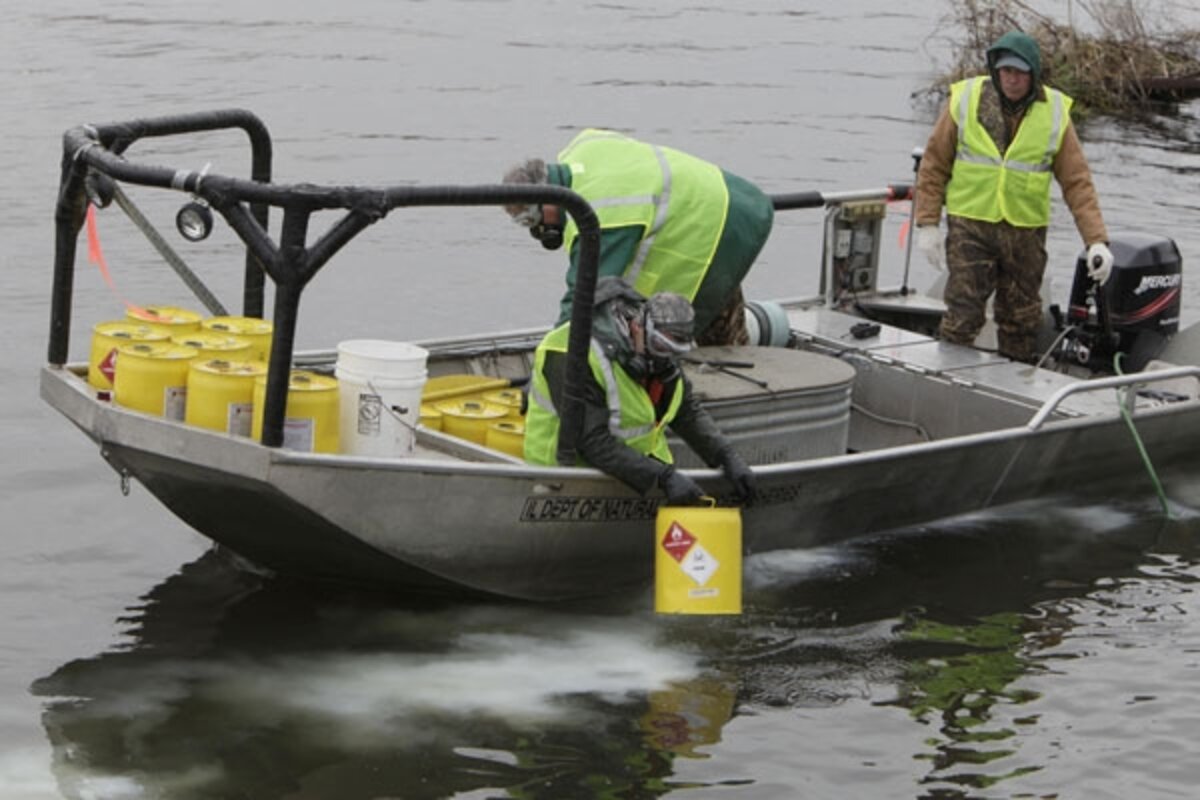Great Lakes states in a fish fight over Asian carp invaders
Loading...
| Chicago
The Great Lakes are under threat from the Asian carp, an invasive species of fish whose presence is pitting neighboring states against Illinois in a showdown with no clear resolution.
Nearly 200,000 pounds of fish were deliberately poisoned Wednesday night in a $3 million effort by federal and state agencies to eradicate the Asian carp from the Chicago Sanitary and Ship Canal, a canal built in 1900 to open up commerce between the Mississippi River and Lake Michigan.
But on Friday, only one Asian carp was found among the thousands of dead fish, which Stacey Solano, spokesperson for the Illinois Department of Natural Resources, confirms as “the furthest north a physical specimen [of the fish] has been found close to the Great Lakes.” She adds, “Now we know 100 percent they are here.”
The single discovery, Ms. Solano says, is motivation enough for the Asian Carp Rapid Response Workgroup, a multi-agency task force that includes the US Army Corps of Engineers, to move forward and figure out “the next steps to protect the Great Lakes.” The reason is environmental as well as economical: The lakes support a $7 billion sports fish industry.
“It’s gotten to the point where we can’t afford not to do anything. We feel this is a definite measure that needed to be taken,” she says.
However, according to environmentalists and neighboring states, the Army Corps and other agencies mishandled the issue and are responsible for allowing the Asian carp’s presence just six miles from Lake Michigan waters.
Michigan Gov. Jennifer Granholm (D) instructed state Attorney General Mike Cox to investigate all legal options against Illinois, including reopening a Supreme Court case determining governing rights of the canal. She is also demanding that the canal be locked down to provide a final wall between the lake and the canal. And she is calling for barriers constructed on intersecting Illinois waterways, such as the Calumet and Des Plaines rivers.
The US Environmental Protection Agency is debating whether to temporarily close the shipping lock located in Lockport, Ill., the Associated Press reported Friday.
A solution like that is one of many being considered, says Col. Vincent Quarles, commander of the Chicago district of the Army Corps of Engineers. But he is cautious to make any rash decisions.
“If we’re going to close an infrastructure like that, we want to be responsible and to consider all impacts it might make,” he says.
Governor Granholm is also asking that the task force explore the possibility of permanently damming up the canal, a measure guaranteed to face political opposition in Chicago. The canal was built to divert drainage away from Lake Michigan, the primary source of Chicago’s drinking water, and to open up barge traffic.
The Natural Resources Defense Council calls this week’s poisoning effort a “last-ditch attempt to protect the lake,” says Josh Mogerman, the organization’s spokesperson. According to Mr. Mogerman, far too much time was allowed to pass without the creation of natural barriers against Lake Michigan, and a permanent separation needs to be built to part it from the Mississippi River.
“It’s not an overstatement to say that the health and water quality is at stake,” he says. “Public forums need to bring in new thinking to the debate, but the process needs to start quickly.”
The Asian carp was introduced as a feeder fish in catfish farms in Arkansas and Mississippi decades ago. The fish is known for dismantling a water system’s natural food chain by consuming the majority of available plankton and growing up to 50 pounds or more.
Water testing will continue later this month in the Chicago canal to determine the carp’s presence, Colonel Quarles says. The second phase of a $9 million electrical barrier will be completed next year above the Lockport dam, he adds.
—�ē
Follow us on .




